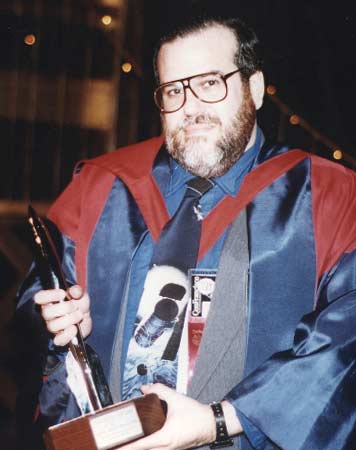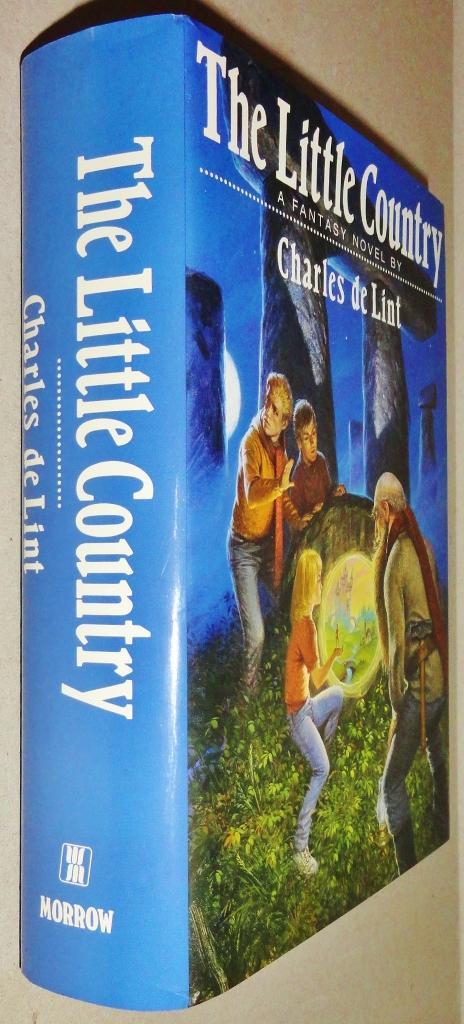(1) BRITISH BOOK AWARDS. The Bookseller reports The British Book Awards “Book of the Year Winners 2025”. One is of genre interest, while James, a retelling of Huckleberry Finn from the viewpoint of Jim, has been discussed here for its parallels to Julia, a 1984 retelling. The complete list of winners is at the link.
AUTHOR OF THE YEAR
- Percival Everett, author of James
BOOK OF THE YEAR – FICTION
- James by Percival Everett
BOOK OF THE YEAR – PAGETURNER
- Faebound by Saara El-Arifi
(2) HUGO-WORTHY POETRY CONSIDERED. Dina at SFF Book Reviews compares all the poetry finalists in “Reading the Hugos 2025: Best Poem”. Here’s one of the comments:
…Ever Noir by Mari Ness was much more to my liking, combining fairy tale tropes with a noir style. It’s like the noir detective in the grimy office is visited by a fairy tale princess. While it doesn’t really tell a story, I really enjoyed the juxtaposition of the two clashing sub-genres. (7/10)…
(3) JOURNEY PLANET 90. Steven H Silver announces that Chris Garcia and James Bacon have published an issue of Journey Planet he edited on the theme “My Favorite Museum”, which is 155 pages and looks at more than 60 museums on all seven continents. The issue can be downloaded at the link.
(4) 2027 WESTERCON. “Santa Clara Bids for 2027 Westercon” reports Kayla Allen at Westercon.org.
The 2027 Westercon Site Selection Administrator announced that she has accepted a bid from the Society for the Promotion of Speculative Fiction (SPSF) to host Westercon 79 in conjunction with BayCon 2027 at the Marriott Hotel in Santa Clara, California, and that this bid will be on the ballot for the election to be held this year at Westercon 77/BayCon 2025.
Site Selection Administrator Kayla Allen explained that there was a misunderstanding between herself and SPSF around the original filing deadline of April 15, 2025. After several discussions, Allen decided in the interest of fairness to accept SPSF’s bid and place the Santa Clara in 2027 bid on the ballot. No other groups filed bids to host Westercon 79.
For those wishing to vote electronically, you will be able to pay the advance “voting fee ($20) tokens” by purchasing a token through the BayCon 2025 website. There is also a small service charge for such online purchases. Members will also be able to pay by check or money order. Cash will only be accepted in person at Westercon 77/BayCon 2025.
The 2027 Westercon Site Selection ballot will be posted at the Westercon.org website and will be sent to all members of Westercon 77/BayCon 2025. Members will be able to vote by email, paper mail, or in person at Westercon 77/BayCon 2025.
(5) STREET’S NEW DESTINATION. “’Sesame Street’ Heads To Netflix With Streaming Deal For PBS Series” – Deadline has the story.
Sesame Street has a new streaming home. Netflix has picked up the children’s series, which will make its debut on the streamer later this year with an all-new, reimagined 56th season — plus 90 hours of previous episodes — available to audiences worldwide.
Netflix is coming on board after HBO Max opted not to renew its Sesame Street streaming deal at the end of last year. Finding a new streaming partner has been considered critical to the series’ financial survival.
The new episodes, which will now each center on one 11-minute story, will be available same day-and-date in the U.S. on PBS stations and PBS KIDS digital platforms, maintaining U.S. kids’ free access to early learning, which Sesame Street is all about. That is a departure from Netflix’s typical push for exclusivity unless a second window on a library title is involved….
(6) 451. In “Ray Bradbury Told Us So”, Carl Abrahamsson analyzes the lasting relevance of Fahrenheit 451. (Behind a paywall.).
…Bradbury’s novel emerged from the McCarthy era, when fear of communist influence led to intense scrutiny of intellectuals and artists. The story follows Guy Montag, a “fireman” whose job is burning books in a future America where literature is forbidden. Through his relationship with Clarisse McClellan, a young woman who questions society’s values, and his own growing disillusionment, Montag begins to read the books he’s meant to destroy. The novel depicts a population numbed by wall-sized televisions, immersive entertainment, and high-speed living. Bradbury’s warning focuses on how mass media and anti-intellectualism could lead to cultural amnesia and the death of critical thinking….
(7) THE BLOB AT REST. [Item by Steven French.] Guardian readers suggest some good books to read to kids, including the ‘How to Train Your Dragon’ series and also this: “’I’m still not tired of it’: the best books to read aloud to kids, according to parents”.
Huw Aaron
I’m a primary school teacher with two children under three at home. As a reception teacher I spend a lot of time reading children’s books out loud. With my own children I like a book that is calm and gives me something as well as them. Sleep Tight, Disgusting Blob by Huw Aaron is my new favourite: Lovely, relaxed rhymes with a touch of sci-fi and horror thrown in. Children who can read or appreciate the pictures love the idea of a “scary” bedtime story, and those who can’t, get the rhythm and time with a happy, giggling parent. Patrick Clark, Leeds’
(8) MEMORY LANE.
[Item by Cat Eldridge.]
May 19, 1983 — Shatner’s Star
Forty-two years ago on this day, William Shatner got his very own star on the Hollywood Walk of Fame. It was the one thousand and sixty-second such star. It’s located at 6901 Hollywood Blvd. He’d also get a star on the Canada’s Walk of Fame in Toronto.
It is said that hundreds of people attended Shatner’s dedication ceremony, including Leonard Nimoy who gave a speech on the day in which he said that Shatner was “a wonderful man and a great actor” before telling the crowd about the terrible jokes Shatner liked to play on him.
Shatner also spoke, “This is my small ticket to the stars. All of the other accolades are so ephemeral one never has anything that’s truly concrete and this is the one exception.”

(9) COMICS SECTION.
- Dustin has a friend who’s skeptical.
- Dinosaur Comics resorts to spy fanfiction.
- Thatababy knows one of these things is not like the others.
- The Flying McCoys realizes the past is distant.
- Wallace the Brave is dedicated to promotion.
- Saturday Morning Breakfast Cereal meets AI moderators determined to rid the internet of pleasure.
- Tom Gauld offers this unconventional advice —
(10) SHARE THE WEALTH? “Mike Deodato On Not Getting Paid For Ironheart By Marvel Studios” at Bleeding Cool.
Mike Deodato co-created Riri Williams, Ironheart, with Brian Michael Bendis for Marvel Comics, who first appeared in Invincible Iron Man Vol. 3 #7 in 2016, and on the screen in Black Panther: Wakanda Forever, played by Dominique Thorne. With the TV series adaptation starring Thorne about to drop on Disney+, he has written an open letter on social media earlier this week, reproduced in English below;…
… “But as much as I celebrate this moment, there’s a bitter edge to it. You see, while Marvel has built an empire worth billions on the backs of its creators, the compensation model hasn’t kept pace with the success. I’m in a good place, one of the best-paid creators in the industry, and I truly appreciate that. But it’s not about me. It’s about the principle. When a character you poured your heart into helps fuel the engine of a multi-billion-dollar machine, a small share of that success feels only fair.
“Creators don’t ask for billions or even millions. Just a nod, a bit of recognition, and a share that reflects the contribution they’ve made. It’s not just good ethics—it’s good business. Happy creators stay invested, inspired, and loyal. But when the business side doesn’t match the creative investment, creators naturally drift toward projects where they retain control, where their work can lead to lasting financial security. That’s why more and more of us are focusing on creator-owned projects, where we can truly share in the success of our creations….”
(11) SOMETIMES IT’S EASY TO BE GREEN. Forbes has news that’s out of this world: “Mars: Why The Red Planet Could Turn Green This Week”.
Mars, the red planet, could be in for a global display of aurora this week after a huge cloud of charged particles left the sun in the direction of the red planet.
The prediction from solar scientists comes in the same week NASA’s Perseverance Mars rover made history by detecting visibly green auroras on Mars for the first time.
An X2.7 solar flare on Wednesday, May 14 — the strongest of the year so far — saw an intense burst of energy and electromagnetic radiation from the sun’s surface spread out across the system at light speed. An X-class solar flare is the most intense class, according to NASA. In its wake, there was a coronal mass ejection — a cloud of super-charged particles — that left the sun’s surface….
(12) THEY’RE LASERS. Oh yeah, now that you mention it. “Something Wild Happens When You Try to Take a Video of a Car’s Sensors” warns Futurism.
Public service announcement: don’t point your phone camera directly at a lidar sensor.
A video recently shared on Reddit demonstrates why. As the camera zooms in on the sensor affixed to the top of a Volvo EX90, a whole galaxy of colorful dots is burned into the image, forming over the exact spot that the flashing light inside the lidar device can be seen.
What you’re witnessing isn’t lens flare or a digital glitch — it’s real, physical damage to the camera. And it’s permanent.
“Lidar lasers burn your camera,” the Reddit user warned….
(13) PITCH MEETING. Ryan George remembers “The Avengers Pitch Meeting” like it was yesterday. Maybe that’s because this is a revival of a video first aired in 2018.
(14) VIDEO OF THE DAY. [Item by SF Concatenation’s Jonathan Cowie.] Matt O’Dowd over at PBS Space Time tends to the sceptical side of technological extraterrestrials existing, at least within detection range of Earth. It is never aliens, except when it is.
However he has just posted a 20-miute video, the latest of a few over the past half-decade, on the Fermi paradox: “Is There A Simple Solution To The Fermi Paradox?”
I should declare that as a bio-geo (environmental) scientist, I don’t buy into this at all. Having devoted much of my extracurricular science time to climate change for over a third of a century, I was really getting depressed, and so for the last decade I have been focusing on deep-time evolution of life, the Earth and the Earth system, developing a ‘co-evolution of life and planet narrative. (I have a book in press coming out on this from an academic publisher – it has been in peer review for two years!. I’ll give Mike the nod when it is due out in case he thinks it might be worth sharing with Filers as there is a fair bit on exobiology in the mix as well as the coming singularity (both being SFnal tropes)).
For what it is worth, I do not consider the endosymbiont process to create a eukaryote (good cell) from a prokaryote (like a simple bacterial cell) a difficult one or a hard evolutionary step. If it was a hard evolutionary step then it is unlikely to have taken place a number of times (which it has). However, physicists will be physicists and this is Matt’s summary…
Around 2 billion years ago, life had plateaued in complexity, ruined the atmosphere, and was on the verge of self-annihilation. But then something strange and potentially extremely lucky happened that enabled endless new evolutionary paths. The first eukaryote cell was born. This may also explain why there are no aliens.
[Thanks to Teddy Harvia, Mike Kennedy, Andrew Porter, Kayla Allen, John King Tarpinian, Chris Barkley, Cat Eldridge, SF Concatenation’s Jonathan Cowie, Mark Roth-Whitworth, Steven French, and Kathy Sullivan for some of these stories. Title credit belongs to File 770 contributing editor of the day ULTRAGOTHA who gets the 1776 reference from the other day.]









